Do you want to learn how to wrap a knife handle with leather strips? It’s a skill that can come in handy for both outdoor and indoor activities. In this article, we will answer some of the most common questions about this process, as well as provide some useful tips to help you get started. So whether you’re looking to improve your outdoor skills or just want a new hobby, keep reading for everything you need to know about wrapping a knife handle with leather strips!
Common Materials of Knife Handles
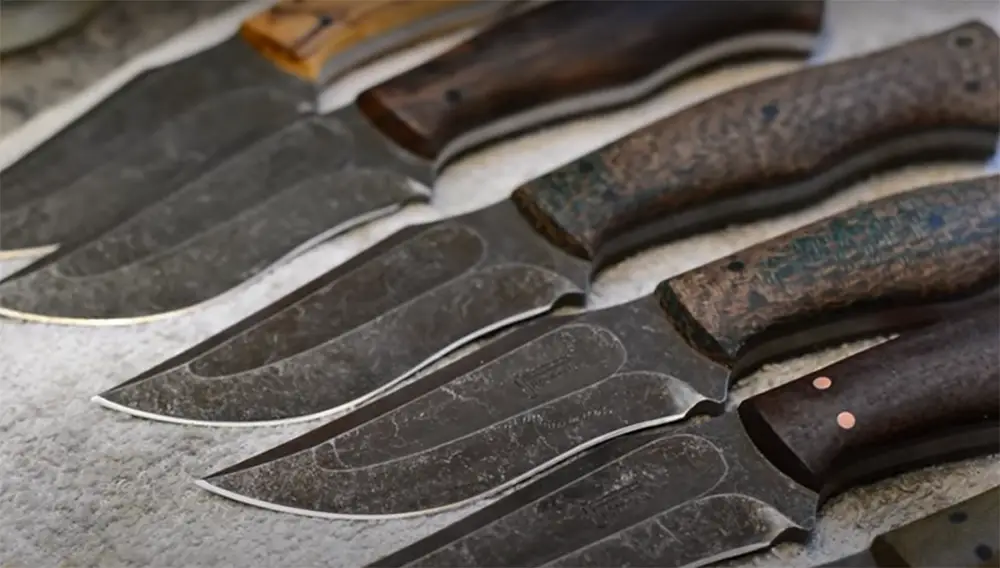
There are generally three types of materials used for knife handles: wood, metal, and carbon fiber.
Wooden Handles
Wooden handles have a classic look and feel that can’t be beat. They’re also very comfortable to hold and provide good grip. However, they require a bit more care than other options and can crack or splinter over time if not properly cared for.
Wood can be difficult to keep clean, and it can absorb water and moisture. This can cause the handle to swell or crack over time.
Metal Handles
If you’re looking for a more modern look, then metal handles are definitely the way to go. They’re also extremely durable and easy to care for. The only downside is that they can be quite slippery and not as comfortable to hold, so if you’re going to be using your knife for precision work, then you might want to consider another option.
Carbon Fiber Handles
Carbon fiber handles are the newest option on the market and offer a number of advantages. They’re extremely strong and lightweight, making them perfect for outdoor activities. They’re also non-conductive, so you don’t have to worry about them getting too hot or cold in extreme temperatures. However, they can be quite expensive and are more brittle than other options. [1]
Why You Should Wrap Your Knife’s Handle
The reasons for wanting to wrap a knife’s handle are many. Let’s see what might fit your particular case the most.
To add extra grip
Adding a wrap to your knife’s handle will give you extra grip, and that can be handy in various situations. For example, if your hands tend to get sweaty when using a knife, or if you’re working with gloves on. For gardeners and those who work with their hands a lot, a good grip can be the difference between being able to use a knife comfortably and not.
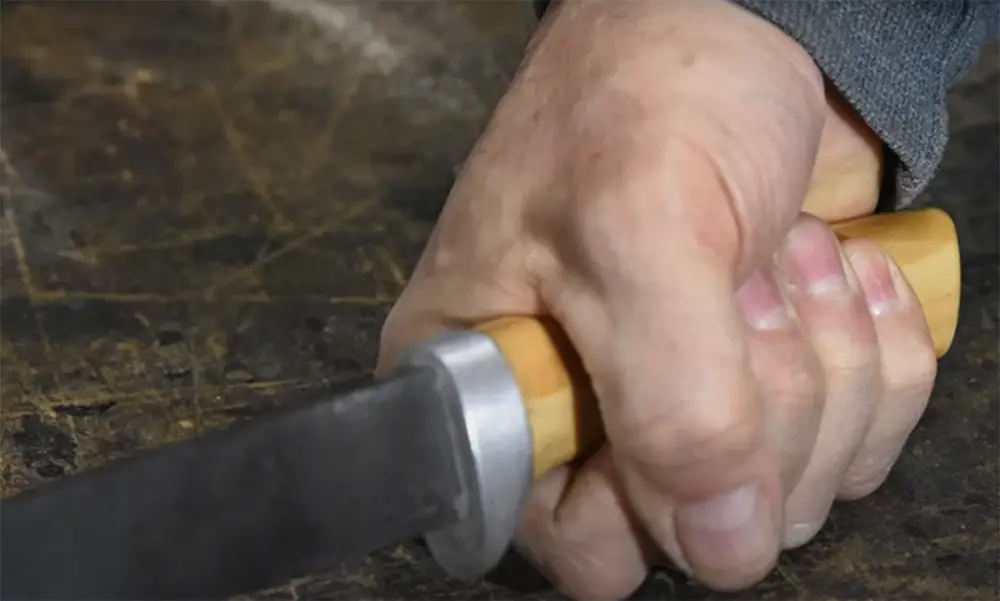
Extra grip can also come in handy if you need to use your knife in an emergency situation where every second counts.
To add extra comfort
It can also help if you have larger hands and need a little extra padding so that the handle doesn’t dig into your palm when you’re using it.
Wrapping the handle in leather can also help absorb shock and vibration, making it easier on your hands when you’re using the knife for extended periods of time.
Protect handle from damage and wear
Wrap up the handle of your everyday carry knife and it will serve you much longer. The leather adds a layer of protection from scratches, dings, and knocks that would otherwise damage the handle material beneath.
On top of that, if you use your knife a lot during work or outdoor activities, the wrap will also absorb some of the sweat and oils from your skin, keeping the underlying material cleaner for longer.
It adds nice appearance
Another common reason why many people choose to wrap their knives for aesthetic reasons. Knife handle wraps come in a wide variety of colors and patterns, so you can really personalize your knife however you want.
Leather wrapping makes your knife look more elegant, adds some contrast to the metal, and in general makes it appear more “finished.” It is an excellent way to dress up a less expensive knife, or one that you have grown attached to but which might not have the greatest resale value.
When you take the time to wrap your own handle, it shows that you care about your tools and take pride in their appearance.
Less maintenance will be required
Leather is a natural material that doesn’t require much maintenance. The main thing you need to do is occasionally condition it, which will help it keep its shape and not dry out.
Wiping the handle down with a damp cloth after each use will also help prolong its life, it’s really not hard at all to care for it. [2], [3]
What Do You Need For the Task
Whether you’re looking to add extra grip, comfort, or protection to your knife, wrapping the handle is a great way to do it. And it’s not as difficult as you might think.
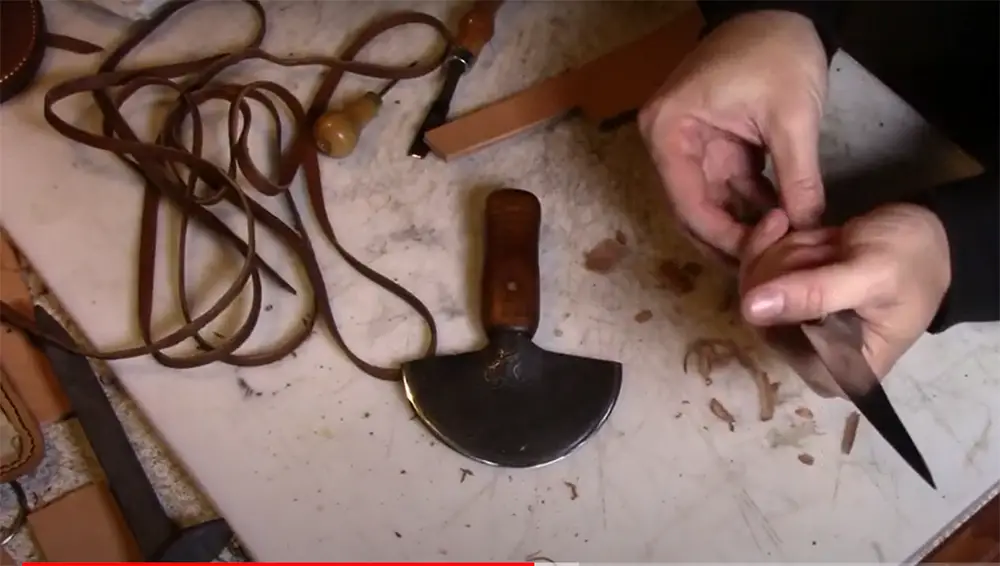
To get started, you’ll need the following tools and items.
A piece of leather
The size of the leather will depend on the size of your knife and how much coverage you want. You can usually find pre-cut pieces of leather at craft stores, or you can cut one to size yourself.
You’ll also want to make sure that the leather is soft so that it’s comfortable to grip, but not too thin that it will tear easily.
Scissors
You’ll need a sharp pair of scissors to cut the leather to size. If you’re cutting your own piece, make sure the scissors are sharp enough to get a clean cut through the leather. You don’t want jagged edges that will make it difficult to wrap the leather around the handle. Fabric scissors are the best choice for this task.
Epoxy
You’ll need epoxy to glue the leather in place. Make sure you get a strong epoxy that will hold the leather securely. You don’t want it to come loose, especially if you’re using your knife for outdoor activities or work where it might get knocked around.
Hard cords
You’ll need something to tie the leather in place while the epoxy dries. You can use just about anything for this, but it’s best to use something that won’t leave a mark on the leather.
Cotton thread or fishing line are both good options. You could also use embroidery thread. Just make sure it’s strong enough to hold the leather in place until the epoxy dries.
Measuring scale
You’ll need something to measure the leather and make sure it’s the right size. A ruler or tape measure will work fine for this.
Marker or a pen
You’ll also need a way to identify the leather so you know where to cut it. A pencil or pen will suffice, although a chalk pencil or embroidery marker is easier to see on the leather. [2], [3], [4]
Wrapping Your Knife’s Handle With Leather Strip
Now that you have all the tools and materials you need, it’s time to get started. wrapping your knife handle with leather strips.
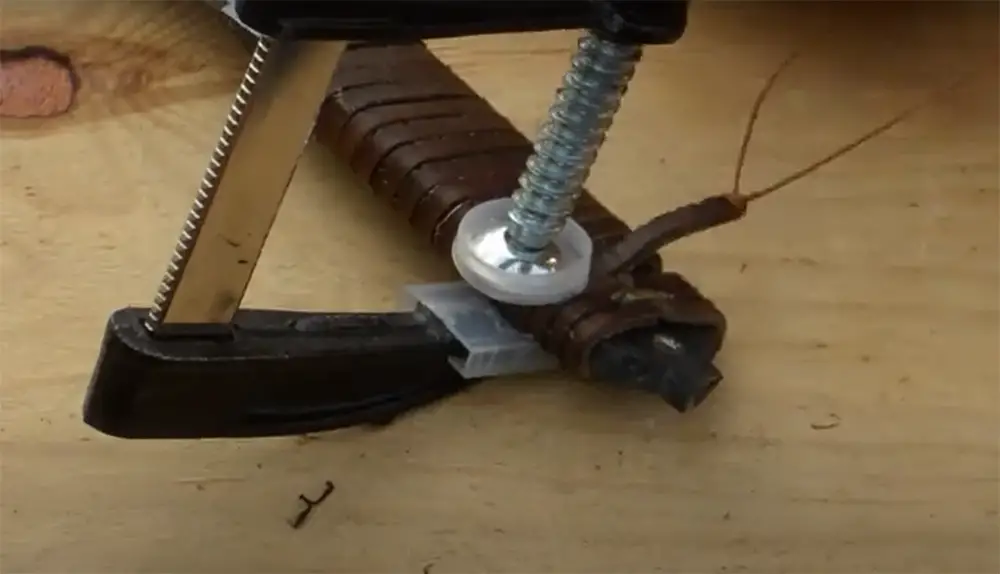
Measure the knife’s handle
Use a measuring tape to determine how long the leather strip will need to be. You can also mark the length with a pen or pencil before cutting the strip to size.
Prepare the piece of leather and cut it in pieces
If you’re cutting the leather yourself, use a sharp knife or scissors to cut it to size. Make sure the pieces are big enough to wrap around the handle and extend past it by about an inch on each side.
Leather pieces should be of equal size for a symmetrical look. If you’re using multiple pieces of leather, make sure they’re the same size so that they wrap around the handle evenly.
Once you have all the pieces cut to size, set them aside until you’re ready to use them.
Soak the leather strips in water to make them softer
This will make them easier to work with and less likely to tear. Simply soak them in a bowl of cold or lukewarm water for about 30 minutes before you begin wrapping the handle.
After the leather has soaked, remove it from the water and pat it dry with a towel. You don’t want it to be dripping wet when you wrap it around the handle.
Make a tight loop starting from the handlebar
Leather is a natural product, which means it’s easy to work with. Start by making a tight loop around the handlebar, making sure the end of the strip is tucked in so it doesn’t come undone.You may also apply epoxy glue to the end of the strip for extra security.
Keep rotating the strips
From there, you can start wrapping the leather around the handle in any pattern or design you like. Just make sure you keep rotating the strips so they don’t get too loose or come undone.
Continue wrapping the leather around the handlebar, making sure each layer is tight against the one before it. If you’re using multiple strips, make sure to overlap them by about half an inch so there are no gaps.
As you wrap, you can also adjust the tension to make the wrapping tighter or looser. Just be careful not to make it too tight or too loose, as this can cause the leather to tear.
Tie another tight string at the end
Once you’ve reached the end of the leather strip, make another tight loop around the handle and tie it off with a string. As we mentioned before, you can use any type of string, but nylon or fishing line works well.
Make a small loop with excesses
After you’ve tied off the end, you can make a small loop with the excess and tuck it under the wrapping. This will help keep the end from coming undone. This is a better alternative to trimming it off, as you can always adjust the tension if needed.
Trimming the excess leather can also make it difficult to re-wrap the handle if you ever need to.
Naturally dry your knife afterwards
Do not put the knife in direct sunlight or heat, as this can cause the leather to shrink and damage the wrapping.
Once it’s completely dry, you can use it as normal. Just be careful not to get the leather wet, as this can cause it to loosen and come undone. [2], [3], [4]
FAQ
How do I attach a leather wrap to a handle?
If you are new to wrapping knife handles, we recommend using adhesive or epoxy as they are easy to work with and will still provide a strong bond.
Once you have chosen your method of attachment, you can begin wrapping the leather around the handle. Start by wrapping one end of the leather strip around the base of the handle and then continue wrapping it tightly up towards the blade. Once you reach the end of the strip, tuck it underneath itself so that it stays in place. Repeat this process with additional strips until the entire handle is wrapped. Once all strips are in place, you can make a knot of any excess leather.
Is wrapping a knife’s handle necessary?
No, it is not necessary but many people prefer the look and feel of a wrapped handle. It can also provide extra grip, which can be helpful if your hands tend to sweat when using the knife.
Why would you want to wrap a knife handle with leather strips?
Knife handles wrapped in leather strips provide a good grip and are less likely to slip out of your hand, especially when wet. Leather is also durable and will last longer than most other materials.
How do you prepare the leather for wrapping the knife handle?
The most important factor in knife handle wrapping is the quality of the leather. Make sure to select a piece of leather that is free of blemishes and has a consistent thickness.
The next step is to remove the excess fat and flesh from the leather. You can do this by using a sharp knife or a scalpel. Be careful not to cut through the leather. Then, use a wet cloth to clean off any blood or dirt from the surface of the leather.
Finally, if you are going to dye the leather, use a brush to apply the dye evenly. Let it dry for several hours before moving on to the next step.
What are some tips for properly wrapping a knife handle with leather strips?
- Cut the leather strips to the desired length and width. Make sure to leave enough extra length on each strip so that you can fold it over the end of the knife handle.
- Apply a thin layer of wood glue to the end of the knife handle and then attach one of the leather strips. Make sure to wrap it tightly around the handle and secure it in place with a few staples or clamps.
- Repeat this process with the remaining leather strips, spacing them evenly along the length of the handle.
- Allow the glue to dry completely before using or storing your knife.
What are the benefits of wrapping a knife handle with leather strips?
There are a few benefits of wrapping a knife handle with leather strips.
- First, the leather provides a better grip for your hand, which can help you to hold onto the knife more securely and prevent it from slipping out of your hand.
- Second, the leather protects your hands from getting cut if you happen to drop the knife.
- Third, the leather also helps to protect the knife itself from being damaged, which can prolong its lifespan.
Is there any drawback to wrapping a knife handle with leather strips?
There is no real drawback to wrapping a knife handle with leather strips, as long as you use a good adhesive. People often find that a knife handle that is designed to fit comfortably in their hand can provide a better grip. This can also make the knife look nicer and more personalized.
Keep in mind that leather may not be the best material for a grip. It can become slippery when wet and it might not be the best option if you’re using your knife in outdoor or extreme environments.
What can you wrap a knife handle with instead of leather strips?
You could wrap a knife handle with paracord. Paracord is a type of nylon rope that is made up of multiple strands of nylon fibers. It is extremely strong and durable, making it the perfect material for wrapping knife handles.
There are many ways to wrap paracord around the handle of your knife. You can use a simple loop or knot it for a more decorative look. You can also dye it to match the color scheme of your knife. Be sure to use plenty of glue to keep the paracord in place and prevent it from unravelling over time.
How do you braid leather handles?
To braid leather handles, you will need a length of thin, soft leather cord, a ruler or measuring tape, scissors, and a strong needle. First, measure and cut the cord to the desired length.
Then use a needle to thread one end of the cord through the hole at the base of the handle. Now, divide the cord into three even pieces and braid them together.
When you reach the end of the handle, use a needle to poke through both pieces of cord and then tie off with a knot. Trim any excess cord with scissors.
How do you wrap a curved handle?
By using a piece of paper or cloth that is slightly larger than the circumference of the handle.
Start by folding the paper or cloth in half, then place it around the handle so that the two ends meet at the top. Next, tie a knot at the top to secure it in place. Finally, twist and tuck the loose ends underneath to finish.
Useful Video: How to make A Leather Knife Handle // Leatherwork
Conclusion
If you want to add comfort and a better grip to your knife, as well as improve its appearance, consider wrapping the handle with leather. It’s an easy process that can be done by anyone and doesn’t require any special tools or skills. All you need is some leather of the right size and a few of the basic household items. The steps you need to follow are pretty simple as well. So why not give it a try? You may be surprised at how much of a difference it makes. We hope you will have a wonderful time while doing this project!
References:
- https://knifeinformer.com/the-ultimate-guide-to-knife-handle-materials/
- https://www.smithfieldgetgrilling.com/wraping-a-knife-handle-with-leather-strips/
- https://leatherhandy.com/how-to-leather-wrap-a-knife-handle/
- https://allaboutknife.com/how-to-wrap-a-knife-handle-with-leather-2/

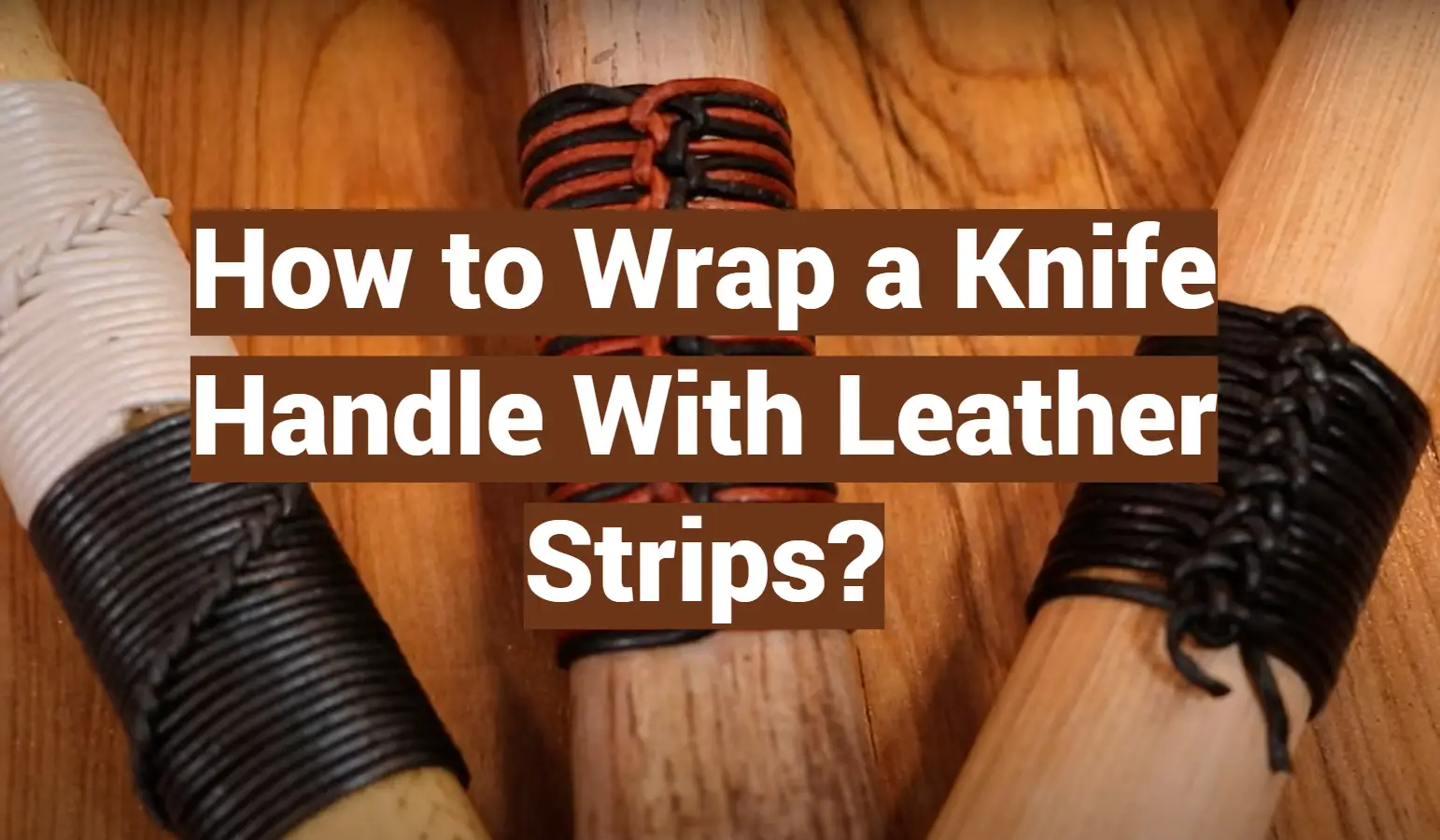

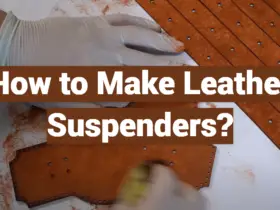
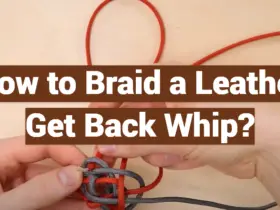
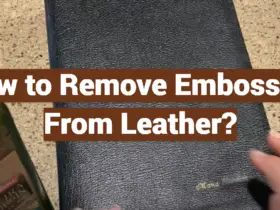

Leave a Reply